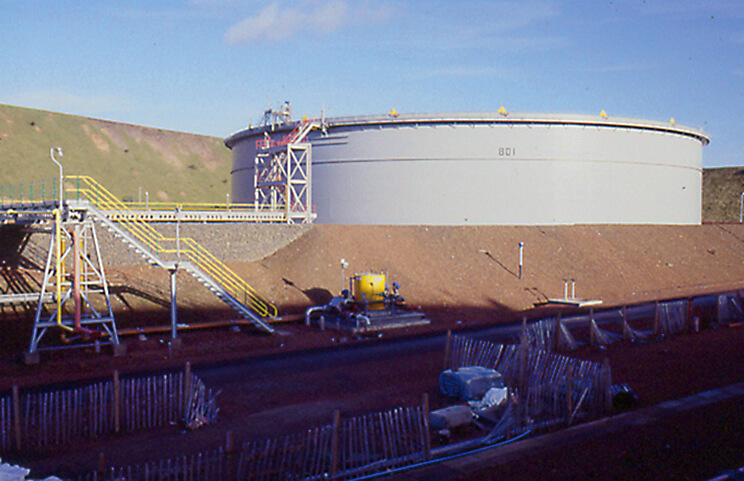 Storage terminals play a critical role in the movements of hydrocarbon-related products through their supply chains. Because large tanks handle hazardous and flammable fluids, safety is of paramount concern. In a series of storage terminal safety podcasts, Emerson experts will share ways that safety, environmental and operational risks can be mitigated.
Storage terminals play a critical role in the movements of hydrocarbon-related products through their supply chains. Because large tanks handle hazardous and flammable fluids, safety is of paramount concern. In a series of storage terminal safety podcasts, Emerson experts will share ways that safety, environmental and operational risks can be mitigated.
Emerson’s Manuel Arroyo, Director, Oil & Gas Industry Programs kicks off this podcast series by highlighting some of the risks & challenges and previews some of the technologies that can help these terminals improve safety, environmental compliance and terminal operations.
Next in this podcast series, we explore Remote and Continuous Floating Roof Monitoring.
You can subscribe to this series and other Emerson Automation Experts podcasts in Apple Podcasts, Google Podcasts, Spotify, Stitcher, TuneIn & Amazon.
Transcript
Jim: Hi, everybody. I’m Jim Cahill from the Emerson Automation Experts blog. And today I’m joined by Manuel Arroyo, and we’re gonna be discussing storage terminal safety as part of the enabling storage terminal safety series. Welcome, Manuel.
Manuel: Thank you, Jim. And hi, everyone. My name is Manuel Arroyo, oil and gas industry leader and subject matter expert at the Emerson Automation Solution. Welcome to our new podcast series on storage terminal, and it’s all about safety. It goes without saying that it is more important than ever to ensure that the storage terminals are efficient and operational. This year as a result of the COVID-19 and the decrease of the crude oil demand, producers and logistic companies need to find places to store that product and building infrastructure will take in between 12 to 24 months.
Jim: So, Manuel, how is the industry growing? And how is it affecting facility managers?
Manuel: Well, you know, terminals need to find a way to increase capacity. So terminal business is around capacity. So the global storage terminal market size is projected to reach around $37 billion by 2027. So on this industry, by nature, it is a high-risk industry. So facilities managers understand the need for increased capacity and safety plays a vital role over there so minimizing these risks can affect the overall oil and gas supply chain.
Jim: So in this storage terminal safety podcast series, what are you and your colleagues planning to cover?
Manuel: Well, my colleagues and I are always finding ways to use the new and existing technologies to reimagine and make our customers’ storage terminal facilities more efficient and safer for employees on call. Do you know, since 2000, we report 75 incidents in the terminals where 242 employees were killed and 1600 injured, and there were losses about $10 billion? So we wanted to share our experience with you and inform you on the recent innovations in digital technology, so you can stay up-to-date and make the right operational decisions for your storage terminal facilities. Another thing, reduce safety risk, increase your shell capacity, and reduce cost. In our storage terminal safety podcast series, we will discuss the beneficial how wireless valve position monitoring help, tank protection systems like a pressure flame and blanketing system, continuous surveillance of floating roof movements, and corrosion and erosion monitoring systems. That can help you to create a safe work environment and improve your operations.
Jim: Yeah, it sounds like wireless technology is increasingly used in different monitoring applications. So why is choosing to monitor with wireless devices such a growing trend? And how could automating with wireless valve position monitoring help make these storage terminals safer?
Manuel: Yeah, that’s a good question, Jim. You know, the terminal industry… it is not new. So terminals were built years ago and right now they handle a really wide range of liquid products, not just two or three, like in the past. So they became more complex facilities. And valves that used to be most of the time closed or open, now, they have to change position constantly and require, you know, increase the visibility, what the position of that valve is from the operator, so to avoid cross-contamination and potential incidents. Typical way to automate valves, it is high cost and wireless is a great option to increase that visibility and kind of a low-cost solution for them.
Jim: So how is modernizing these facilities creating a safer environment for the staff there and preventing explosions? As you said, it’s very volatile end-products that they’re storing.
Manuel: Yeah, absolutely. You know, new technologies allow to have better pressure control. In order to manage the pressure with normal operation and there are many opposite situation in a safety manner. Actually, a few months ago, there was an explosion in Southeast Texas where two people were injured. And those are not the reasons that companies want to be in the newspaper, right?
Jim: I know companies want to stay out of the newspaper beyond just the safety and the health of the employees, the damage to the brand that can bring. That’s not good at all. Now, I know with these tanks, there is different fix roofs and floating roofs and different types of ways that there set up. Are floating roofs preferred to other ways of doing it? And what other associated maintenance challenges do they have?
Manuel: Yeah, floating roofs are widely used… really, really wide use in this industry. But these floating roofs with time, they lose the seal. They start thickening and with the high risk to get a spark. So, by the way, the majority of the fires reported since 2000, the 70 that I mentioned, were just because the seal leaks and mechanical failures. And that’s the reason of all those challenges.
Jim: Is corrosion and erosion a problem that this industry faces like other industries?
Manuel: Yeah, well, I mean, terminal managers, they have several tons of steel sitting there from jetties in contact with salt water when they have marine terminals to tanks that they’d receive rain all the time and corrosion is a risk at their facilities all the time. Lack of visibility can cost millions of dollars if they lose that containment.
Jim: Yeah, and I guess traditionally manual inspection was the way to do it but there’s opportunities for automation to come into play, I imagine.
Manuel: That is correct. And, again, wireless has been the right solution to face all those different challenges that we didn’t face in the past.
Jim: Well, I really look forward to some of the future podcasts going into some of these areas and different ways to monitor, to help… because you’re right, in the world where everything was manual inspections and other things, the results and the safety risks are great in that way. So, Manuel, where can our listeners go to learn more? And how can they get in touch if they want to contact you directly?
Manuel: Yeah, we invite you to learn directly from our experts by tuning into the storage terminal safety podcast series. So you can also go to emerson.com/terminal-safety to learn more. And if you want to get in contact with me, you can find me on LinkedIn, Manuel Arroyo.
Jim: Well, that’s a great introduction, and we look forward to speaking with all of the experts and bringing it out to our listeners. So, Manuel, thank you so much for joining us today.
Manuel: Thank you, Jim.
End of transcript.





